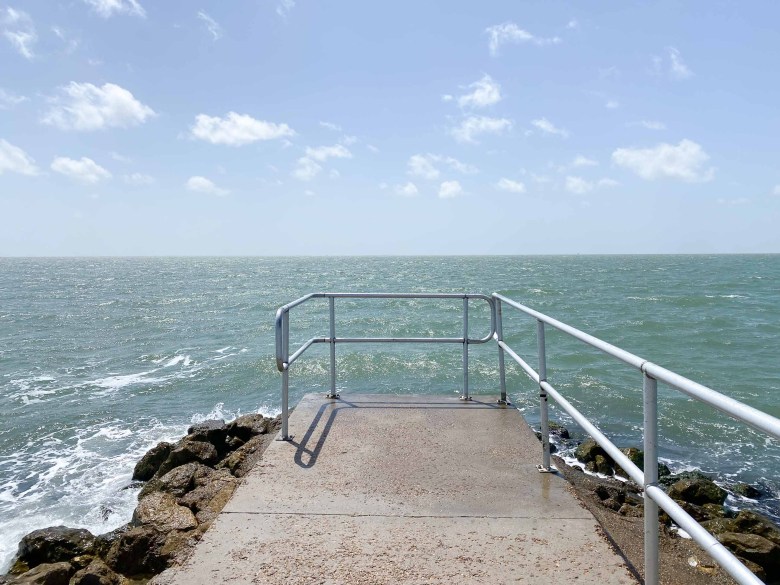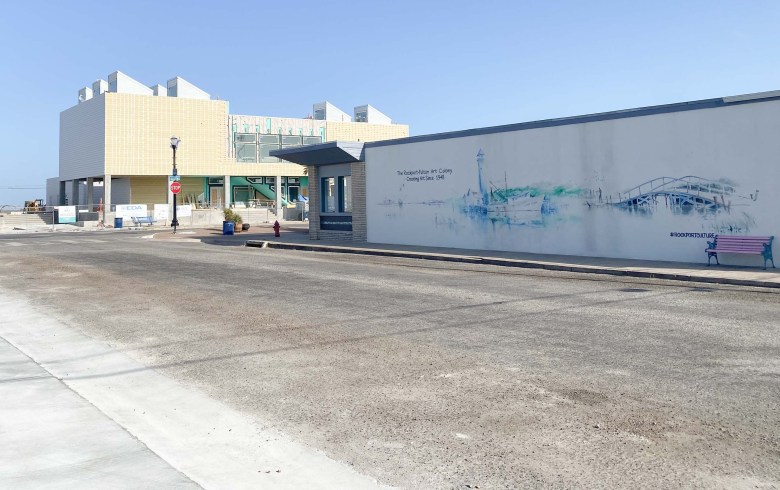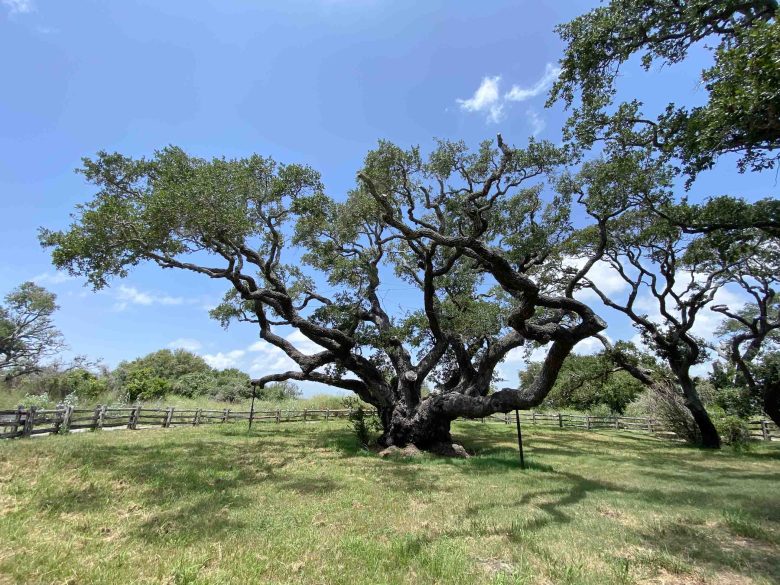- Hurricane survival kit: How to keep your family safe when a hurricane hits
- Houston-area storm damage: Update on status of schools, power outages and resources for storm victims
- EF-1 tornadoes ripped through Cypress, Waller County areas with winds at more than 100 mph, NWS reports
- Houston-area storm damage updates: Clean up continues after NWS says two EF-1 tornadoes and powerful derecho ripped through SE Texas
- Low risk of damaging winds, hail from Saturday storms
Rockport’s artists bend but refuse to break after Hurricane Harvey

This is the sixth in an occasional series exploring Texas locales near and far that offer uncommon sights and experiences.
In the days before Hurricane Harvey wreaked coastal devastation, the chief symbol of Rockport’s staying power would have been the Big Tree, a live oak anchored on sandy soil near the coast for an estimated 1,000 years or more.
Five years on from Harvey, that symbol might now be the Rockport Center for the Arts, an $8.7 million new construction state-of-the-art building rising more than two stories above South Austin Street.
The old Victorian mansion housing the former arts center was one of many buildings in town destroyed by Harvey’s fierce 140-mile-per-hour winds, its spot overlooking Rockport Harbor now a plain grassy lot.
Few other signs of the Category 4 hurricane’s devastation are visible, chiefly unrepaired piers and lifeless palm trees. Thanks to significant federal disaster relief and an outpouring of donations, “Rockport bounced back very rapidly,” said Anita Diebel, one of several artists on the gallery row along Austin Street.
Diebel is one of perhaps 200 artists who make up Rockport’s still-thriving art community, a distinctive feature of the seaport town of 10,000.
A different kind of wind energy
Rockport’s history can be gleaned from various guidebooks, websites, and institutions, including the Texas Maritime Museum and the Aransas County History Center. Or a curious visitor can just talk to knowledgeable locals like Diebel, who served as director of the art center from 1998 to 2003.
She dates the arrival of artists to Rockport back to the late 1860s when cattlemen established an industry based mostly on hide and tallow shipping from the seaport.
“Yet there was nothing here for families and young people,” she said. “So they started art lessons, getting together and painting, having little shows. And then also having piano recitals and things for the kids. I think that was the spark of it.”
Others date the establishment of Rockport as an artists’ haven to the late 1940s, when painter Simon Michael began teaching classes, eventually establishing a school. A downtown mural by Rockport old-timer Steve Russell fixes the date alongside a washy coastal scene resembling a large watercolor, reading “The Rockport-Fulton Art Colony Creating Art Since 1948.”
Diebel’s own history in town dates back to 1997, when she established Wind Way Gallery, named in recognition of Rockport’s most persistent feature.
“We have to fight the wind,” she said, a problem for working plein air — the art tradition of scenic outdoor painting that draws many painters to Rockport — but other qualities make up for that.
“We have everything here for artists, and artists seem naturally to gather where there’s an energy and there’s light,” she said. “We have great sunrises and sunsets,” with Aransas Bay to the east and the coast of Copano Bay to the west.
Diebel is a strong supporter of the new Rockport Center for the Arts and credits it with jump-starting the town’s recovery after Harvey.
“They didn’t miss a beat,” she said, restarting Free Family Saturdays a mere 23 days after the storm hit.
“That was the most important thing you could do,” she said to the center’s current executive director Luis Puron during a visit to her gallery and studio. “Because kids were traumatized, things were not normal at all back then, and the arts have always been therapeutic.”

Bouncing around before bouncing back
To get the art center back up and running, Puron had to be as creative as an artist to find a new space. With the former building declared a total loss due to significant wind damage to the roof, Puron sought temporary shelter in the historic Kline’s Cafe deco-era building on Austin Street.
In an act of foresight that now seems providential, Puron had begun a capital campaign four days before the storm hit on Aug. 25, 2017, looking toward an arts center expansion.
The hurricane changed the initial goal into a major gift campaign to build a whole new center, with the focus squarely on an empty lot in the heart of the downtown arts district.
The vision for the new Rockport Center for the Arts included a 16,000-square-foot outdoor sculpture garden and an 8,000-square-foot events center next door to the 13,000-square-foot main building which would house galleries, educational facilities, and a gift shop with a gallery for the center’s 600 member artists.
One caveat: the Kline’s building stood in the way. Thanks to a deep respect for how much the community values its architectural heritage — and significant private funding — the building was moved mostly intact to a new location four blocks south. Now housing the Shopping with Siobhain antique store owned by Siobhain Anders of News 4 San Antonio, the building’s one loss was the entrance floor mural by San Antonio artist Louis Vega Treviño, of which only a fragment remains.
During construction, Puron moved arts center programming to two other Austin Street locations, the Baker Law building and a historic brick building that once housed the Estelle Stair gallery.
When the new center finally opens its doors in October or November, the five-year cycle of devastation and regeneration will be complete.

A ‘sleepy town’ awakens
Not every Rockport resident is in full support of the grand new center towering above the row of one-story shops downtown. For some, it will block their view of Aransas Bay. Others feel the modern architectural style clashes with the small town coastal feel, while some worry about rising rents pricing them out of their studios and galleries.
“What’s being lost is the sleepy town that I moved to here seven years ago,” Puron said. Rockport now “has a little faster pace,” he said.
For supporters, the benefits outweigh the risks. Diebel reflected the prevailing sentiment when she said that Rockport is already well regarded for its art scene, “but [the new art center] will top it. It will just be amazing. I see more artists coming here, I see more galleries opening up,” and more patrons to appreciate and purchase the art.
Ceramist Stan Irvin moved to Rockport from Austin when he retired from his 38-year career as a teacher leading the ceramics program at St. Edward’s University. He and his spouse first lived on a sailboat in the harbor before buying a house on the bay — right next to the new Rockport Center for the Arts — three months before Harvey hit.
The house survived mostly intact, but the metal-walled studio out back took significant damage. Insurance and hard work got it back into working shape, and the studio is now open for casual walk-ins to check out Irvin’s wares.
Over noise and bustle from the construction site next door, Irvin said he and his wife are very supportive of the new center. “It’s bigger now than what it was planned to be originally, but I think it’s gonna be a great thing for the downtown.”
Natural inspiration
Talking of Rockport’s other features, Irvin mentioned the Big Tree, which is accessible with a quick drive across the LBJ Causeway leading across Copano Bay.
Though it has weathered perhaps a millennium or more of winds and hurricanes, the Big Tree looks to have had as much infrastructure help as Rockport. Metal braces prevent heavy-leaning limbs from falling, and guy-wires and lightning rod cables stabilize the tangle of spidery limbs splaying into the sky.
The tree sits silent amid a grove of smaller live oaks, protected by a wooden fence with a sign that explains little about the tree but relates a poem, asks visitors to refrain from climbing and suggests donations for the upkeep of the site.

The local drive to preserve a longstanding institution also persists on the south side of town, where the Connie Hagar Cottage Sanctuary sits tucked into a bayside residential neighborhood.
Hagar is famous for gracing the cover of LIFE magazine in 1954 as a dedicated birdwatcher. She charted the avian life of the coastal area daily for 35 years, and a foundation set up to preserve her legacy continues the birdwatching tradition. Studious watchers can add to the list of 82 species listed on placards at the entrance to a trail winding through the 11-acre property.
Hagar’s legacy literally put Rockport on the map for naturalists, with the first official marker of the 500-mile Great Texas Coastal Birding Trail located in the sanctuary.
Even as his past half-decade has been spent in diligent pursuit of preserving and building architecture, on a driving tour of town Puron pointed out an appropriate symbol for Rockport’s bend-but-don’t-break philosophy: the windswept oaks of Little Bay.
Unusual for a coastal area, Rockport is already pleasantly crowded with live oaks casting shade in every open lot. But Bent Oaks Rookery Park on Broadway Street just north of downtown holds a stand of oaks conditioned by the constant gulf winds to lean landward, their leafy canopy sweeping gracefully upward as if caught in motion.
While the town’s trees are sometimes lost to storms and encroaching development, if given voice, they might echo the 82-year-old Diebel’s resilience in charting her post-Harvey recovery: “I lost my house, my studio and 95% of my artwork. And I’m back.”
If You Go
How to Get There
Wanderers might prefer the more scenic two-and-a-half-hour route of Texas Highway 181, which meanders through quaint towns including Floresville, Kenedy and Beeville. U.S. Highway 37 South is more direct, but both routes converge in Sinton, which was surrounded by blooming cotton fields in early August.
Where to Stay
For those willing to pay in the several hundreds, Rockport offers many Airbnb and local hotel options on or near the coast, including at least one rentable condo with a boat slip. Candlelight Cottages By the Beach offers a more affordable option within an easy walk to the water.
Other options include affordable Airbnb stays south and east of downtown, including a tiny home cottage where live oaks abound and cicadas sing in their branches for around $200 mid-week.
Where to Drink & Dine
Seafood lovers will appreciate Rockport’s maritime menus, with signature crab cakes at Latitude 28°02′ Restaurant and Art Gallery, which also offers a plentiful selection of local art focused on waterfowl, blue crabs and other Gulf Coast fauna. East coast transplants run 495 Chesapeake Eats, with a full bar and a menu featuring such specialties as baked oysters with bacon, leek and melty fontina cheese fondue, and Maryland deviled eggs with shrimp and crab.
Tex-Mex abounds in Rockport. The chilaquiles at Arandas Mexican Grille make a fine breakfast, and a sign in the dining room that reads “We are not a fast food restaurant” assures that no one’s in a rush, and the food will arrive freshly prepared and piping hot.
The Rockport Daily Grind coffee shop one block from the Rockport Center for the Arts serves a full café menu, and the Fresco Eats health food restaurant on the Market Street strip offers a selection of freshly made smoothies, juices, and breakfast and lunch bowls. On the less health-conscious side, the friendly Mobile Eats food truck serves up a delicious array of burgers and sandwiches.